present-simple-practice-time-daily-actions-adverbs-grammar-drills-tests_90159
美英国小学教材资料 present-simple-vs-present-continuous-worksheet
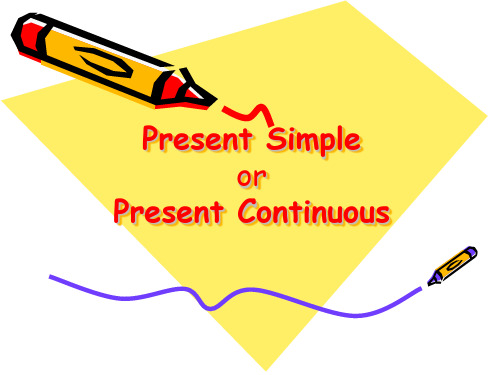
We use PRESENT SIMPLE…
4. For actions that are scheduled.
The train leaves at 9 p.m. The lessons start at 8 o’clock in the morning.
Adverbs of frequency and time phrases
We use PRESENT SIMPLE…
1. For facts or things that are always or generally true. Water boils at 100 C. It rains a lot in Lithuania. The sky is blue.
We use PRESENT SIMPLE…
Time expressions we use with PRESENT CONTINUOUS
now, at the moment, at present, these days, nowadays, today, tonight
My mother is cooking at the moment. I am going dancing tonight.
Questions and short answers
We form questions by putting auxiliary do or does or any form of the verb BE before the subject: Do you live in the USA? Yes, I do. / No, I don’t. Does she study medicine? Yes, she does. / No, she doesn’t. Are they friends? Yes, they are. /No they aren’t.
Simple Present Tense
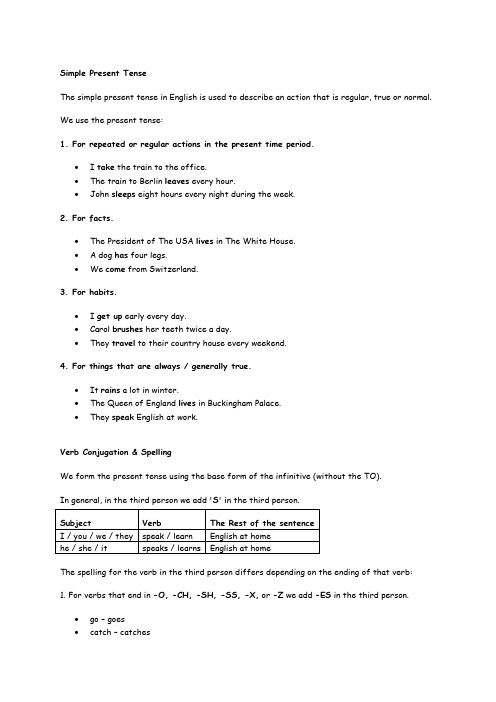
Simple Present TenseThe simple present tense in English is used to describe an action that is regular, true or normal. We use the present tense:1. For repeated or regular actions in the present time period.•I take the train to the office.•The train to Berlin leaves every hour.•John sleeps eight hours every night during the week.2. For facts.•The President of The USA lives in The White House.• A dog has four legs.•We come from Switzerland.3. For habits.•I get up early every day.•Carol brushes her teeth twice a day.•They travel to their country house every weekend.4. For things that are always / generally true.•It rains a lot in winter.•The Queen of England lives in Buckingham Palace.•They speak English at work.Verb Conjugation & SpellingWe form the present tense using the base form of the infinitive (without the TO).In general, in the third person we add 'S' in the third person.The spelling for the verb in the third person differs depending on the ending of that verb: 1. For verbs that end in -O, -CH, -SH, -SS, -X, or -Z we add -ES in the third person.•go – goes•catch – catches•wash – washes•kiss – kisses•fix – fixes•buzz – buzzes2. For verbs that end in a consonant + Y, we remove the Y and add -IES.•marry – marries•study – studies•carry – carries•worry – worriesNOTE: For verbs that end in a vowel + Y, we just add -S.•play – plays•enjoy – enjoys•say – saysNegative Sentences in the Simple Present TenseTo make a negative sentence in English we normally use Don't or Doesn't with all verbs EXCEPT To Be and Modal verbs (can, might, should etc.).•Affirmative: You speak French.Negative: You don't speak French.You will see that we add don't between the subject and the verb. We use Don't when the subject is I, you,we or they.•Affirmative: He speaks German.Negative: He doesn't speak German.When the subject is he, she or it, we add doesn't between the subject and the verb to make a negative sentence. Notice that the letter S at the end of the verb in the affirmative sentence (because it is in third person) disappears in the negative sentence. We will see the reason why below.Negative ContractionsDon't = Do notDoesn't = Does notI don't like meat = I do not like meat.There is no difference in meaning though we normally use contractions in spoken English.Word Order of Negative SentencesThe following is the word order to construct a basic negative sentence in English in the Present Tense using Don't or Doesn't.* Verb: The verb that goes here is the base form of the infinitive = The infinitive without TO before the verb. Instead of the infinitive To have it is just the have part.Remember that the infinitive is the verb before it is conjugated (changed) and it beginswith TO. For example: to have, to eat, to go, to live, to speak etc.Examples of Negative Sentences with Don't and Doesn't:•You don't speak Arabic.•John doesn't speak Italian.•We don't have time for a rest.•It doesn't move.•They don't want to go to the party.•She doesn't like fish.Questions in the Simple Present TenseTo make a question in English we normally use Do or Does. It has no translation in Spanish though it is essential to show we are making a question. It is normally put at the beginning of the question.•Affirmative: You speak English.Question: Do you speak English?You will see that we add DO at the beginning of the affirmative sentence to make it a question. We use Do when the subject is I, you, we or they.•Affirmative: He speaks French.Question: Does he speak French?When the subject is he, she or it, we add DOES at the beginning to make the affirmative sentence a question. Notice that the letter S at the end of the verb in the affirmative sentence (because it is in third person) disappears in the question. We will see the reason why below.We DON'T use Do or Does in questions that have the verb To Be or Modal Verbs (can, must, might, should etc.)Word Order of Questions with Do and DoesThe following is the word order to construct a basic question in English using Do or Does.*Verb: The verb that goes here is the base form of the infinitive = The infinitive without TO before the verb. Instead of the infinitive To have it is just the have part.Remember that the infinitive is the verb before it is conjugated (changed) and it beginswith TO. For example: to have, to eat, to go, to live, to speak etc.Examples of Questions with Do and Does:•Do you need a dictionary?•Does Mary need a dictionary?•Do we have a meeting now?•Does it rain a lot in winter?•Do they want to go to the party?•Does he like pizza?Short Answers with Do and DoesIn questions that use do/does it is possible to give short answers to direct questions as follows:However, if a question word such as who, when, where, why, which or how is used in the question, you cannot use the short answers above to respond to the question.。
2024-2025学年牛津译林版初一上学期期中英语试卷及解答参考
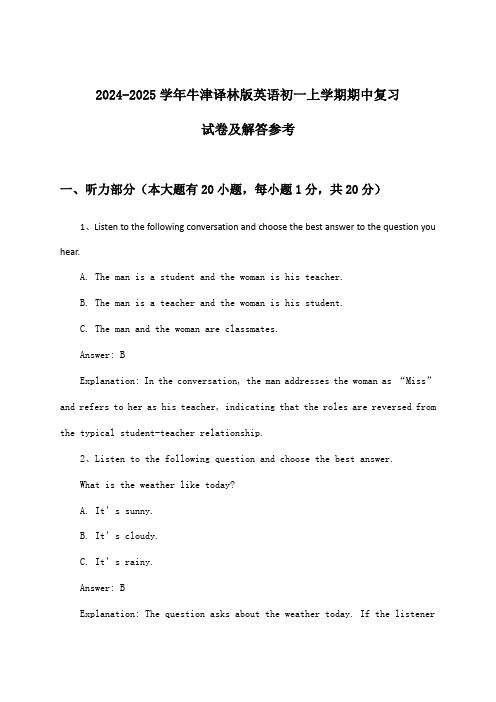
2024-2025学年牛津译林版英语初一上学期期中复习试卷及解答参考一、听力部分(本大题有20小题,每小题1分,共20分)1、Listen to the following conversation and choose the best answer to the question you hear.A. The man is a student and the woman is his teacher.B. The man is a teacher and the woman is his student.C. The man and the woman are classmates.Answer: BExplanation: In the conversation, the man addresses the woman as “Miss” and refers to her as his teacher, indicating that the roles are reversed from the typical student-teacher relationship.2、Listen to the following question and choose the best answer.What is the weather like today?A. It’s sunny.B. It’s cloudy.C. It’s rainy.Answer: BExplanation: The question asks about the weather today. If the listenerhears “It’s a bit cloudy,” the correct answer would be B, “It’s cloudy.” If the weather is mentioned differently, the answer should reflect that information.3、Listen to the conversation between two students and answer the question. Student A: Hey, have you finished your science project yet?Student B: Not yet, I’m still working on it. I have to research about the solar system.Question: What is Student B working on for their science project?A) A book about the solar systemB) A research paper on the solar systemC) A model of the solar systemD) A video about the solar systemAnswer: B) A research paper on the solar systemExplanation: The key information here is “I have to research about the solar system,” which indicates that Student B is working on a research paper.4、Listen to the dialogue and choose the correct option to complete the sentence.Teacher: Today we are going to talk about the different seasons. Can you tell me which season is characterized by warm weather and long days?Student: _______.A) SpringB) SummerC) AutumnD) WinterAnswer: B) SummerExplanation: The question asks for the season characterized by warm weather and long days, which is summer. The other options do not match the given description.5、Listen to the conversation between two students in the library and answer the question.Student A: Hi, have you finished reading the book for the English assignment? Student B: Not yet, I was up until midnight trying to finish it.Question: What is the topic of the conversation?A) Homework deadlinesB) Library rulesC) Reading a bookD) Library eventsAnswer: A) Homework deadlinesExplanation: The conversation revolves around the book that Student B was trying to finish for an English assignment, indicating that the topic is related to homework deadlines.6、Listen to a short dialogue about a school trip and complete the following sentence.Teacher: Alright, class, let’s discuss the upcoming science trip to the museum.Student: Great! We’re going on Friday, right?Teacher: Yes, and remember, we need to bring our science notebooks and pens. Student: Oh, and we should also bring some snacks, right?Question: What should the students bring on the science trip?A) Science textbooksB) Snacks and science notebooksC) Library booksD) Art suppliesAnswer: B) Snacks and science notebooksExplanation: The teacher specifically mentions that students need to bring their science notebooks and pens, and the student inquires about bringing snacks, implying that both are required for the trip.7、Listen to the conversation between two students, Tom and Alice, discussing their weekend plans. Choose the best answer to complete the following sentence.Tom: “I was thinking of going hiking this weekend, but…”Alice: “That sounds great! You know, I have a fr iend who goes there often. He says the trails are…”A) very easyB) quite difficultC) always crowdedD) not very longAnswer: B) quite difficultExplanation: The clue is in Alice’s response, “He says the trails are,” which implies that the trails are challenging. Therefore, “quite difficult” is the correct answer.8、You will hear a short dialogue between a teacher and a student about a school project. Listen carefully and answer the following question.Teacher: “How is your science project coming along, John?”John: “Well, I’ve been working on it for a few days, but I’m not sure if…”Teacher: “Don’t worry, John. Just make sure you focus on…”A) your safetyB) the deadlineC) your classmatesD) the instructionsAnswer: D) the instructionsExplanation: The teacher’s response, “Just make sure you focus on…” suggests that the main concern is about following the directions or instructions for the project. Thus, “the instructions” is the correct answer.9、You will hear a short dialogue between two students discussing their weekend plans. Listen carefully and choose the best answer to the question that follows.Question: What are the students planning to do on Saturday afternoon?A) Go to a movie.B) Visit a museum.C) Have a picnic in the park.D) Stay home and relax.Answer: A) Go to a movie.Explanation: In the dialogue, one student suggests going to a movie, and the other agrees. Therefore, the correct answer is option A.10、You will hear a short passage about the importance of exercise. Listen carefully and answer the question that follows.Question: According to the passage, what is one of the main benefits of regular exercise?A) Improved academic performance.B) Enhanced creativity.C) Better mental health.D) Increased energy levels.Answer: C) Better mental health.Explanation: The passage mentions that regular exercise can have a positive impact on mental health, reducing stress and improving mood. Option C is the best answer based on the information provided.11.You are listening to a conversation between two students, Tom and Lucy, about their weekend plans.Tom: Hey Lucy, are you planning to go anywhere this weekend?Lucy: Yeah, actually, I’m going to visit my grandparents in the countryside. How about you, Tom?Tom: O h, I think I’ll just stay home and read some books. I have a lot of homework to catch up on.Question: What is Tom’s plan for the weekend?A) Visit his grandparentsB) Go to the countrysideC) Stay home and read booksD) Go on a tripAnswer: C) Stay home and read booksExplanation: In the conversation, Tom mentions that he plans to stay home and read some books, indicating that his plan is to catch up on his homework.12.You are listening to a news report about a new app that helps students study more efficiently.News Anchor: According to the latest report, a new app called “SmartStudy” has been released to help students improve their study habits. The app uses advanced algorithms to analyze a student’s study habits and provide personalized recommendations.Question: What is the purpose of the “SmartStudy” app?A) To entertain studentsB) To provide personalized study recommendationsC) To teach students new subjectsD) To track a student’s locationAnswer: B) To provide personalized study recommendationsEx planation: The news report states that the “SmartStudy” app uses advanced algorithms to analyze a student’s study habits and provide personalized recommendations, indicating that its purpose is to help students study more efficiently by giving them tailored advice.13.You are listening to a conversation between two students discussing their weekend plans.Question: What activity does the girl want to do this weekend?A. Go shopping.B. Visit a museum.C. Go to the cinema.Answer: BExplanation: The girl mentions, “I was thinking of visiting the local museum this weekend,” which indicates her interest in visiting a museum. Therefore, the correct answer is B.14.Listen to a short dialogue between a teacher and a student about a school project.Question: What does the student need help with for the project?A. Researching the topic.B. Organizing the presentation.C. Writing the conclusion.Answer: AExplanation: The student says, “I’m really struggling with finding goodsources for my r esearch,” indicating that the student needs help with researching the topic. Thus, the correct answer is A.15、Listen to the following dialogue and choose the best answer to the question you hear.A. They are discussing the weather.B. They are planning a trip.C. They are talking about a book.Answer: BExplanation: The dialogue is about two friends discussing their plan for a trip. They are talking about the places they want to visit and the activities they want to do.16、Listen to the passage and answer the question.What is the main idea of the passage?A. The importance of exercise for children.B. The benefits of reading books.C. The role of music in our lives.Answer: AExplanation: The passage highlights the importance of exercise for children’s phy sical and mental health. It discusses various benefits of regular exercise and encourages children to participate in sports activities.17.You are listening to a conversation between two students discussing their weekend plans.A. What did the first student say about their weekend?1.They plan to go hiking.2.They will study for the upcoming exam.3.They are going to visit their grandparents.Answer: 2Explanation: The first student mentions that they have an important exam coming up and they need to study.18.You are listening to a weather report for a major city.A. What is the weather forecast for the city today?1.Sunny and warm.2.Rainy and cold.3.Cloudy with a chance of snow.Answer: 3Explanation: The weather report specifically mentions that there is a chance of snow in the forecast for the city today.19.Listen to the conversation and answer the question.W: Hi, John. How was your math test yesterday?M: Not too bad, I guess. But I’m not sure about the last question.W: The last question? Which one?M: The one about finding the area of a triangle.W: Oh, that one. You just need to use the formula for the area of a triangle, which is (base x height) / 2. Did you remember that?M: Yeah, but I was confused because the problem didn’t give the height.W: Well, if you don’t have the height, you can use the Pythagorean theorem to find it. Do you know the Pythagorean theorem?M: Yeah, it’s a^2 + b^2 = c^2, right?W: Exactly. So, if you have the lengths of the two sides of the triangle, you can use the Pythagorean theorem to find the length of the third side, and then you can use that to find the height.M: Oh, I see. Thanks for the help!Question: What is the main topic of the conversation?A) A student’s difficulties in a math test.B)The importance of the Pythagorean theorem.C)How to find the area of a triangle.D)The use of formulas in math.Answer: C) How to find the area of a triangle.Explanation: The conversation focuses on a student’s confusi on about finding the area of a triangle and how to solve it, which is option C.20.Listen to the dialogue and choose the best answer to the question.M: Hey, Lily, did you finish reading the book for English class?W: Yeah, I did. It was really interesting. The author talks about the impact of social media on our lives.M: Oh, I haven’t started it yet. What did you find most interesting?W: Well, one thing that stood out to me was the author’s argument that social media can be both a positive and negative influence.M: Really? I didn’t know that. What are some examples?W: The author mentions how social media can help people stay connected with friends and family, but it can also lead to feelings of loneliness and depression.M: That’s an interesting point. Do you think we should be more careful about how we use social media?W: Definitely. We need to be aware of its potential negative effects and try to use it in a healthy way.Question: What is the main topic of the conversation?A)The benefits of reading.B)The impact of social media on our lives.C)The author’s writing style.D)The use of technology in education.Answer: B) The impact of social media on our lives.Explanation: The conversation revolves around the discussion of the impact of social media on our lives, as mentioned by the author of the book, making option B the correct answer.二、阅读理解(30分)Reading ComprehensionPassage:In the small town of Greenfield, there was a library that had been there for over a century. The library, known as the Greenfield Public Library, wasa place where people of all ages came to read, learn, and connect with each other. The library was filled with thousands of books on every subject imaginable, and it had a cozy reading room where people could sit and enjoy a good book.One day, a young girl named Lily walked into the library for the first time. She was 12 years old and had always been fascinated by stories. Lily had heard about the library from her grandmother, who used to visit it often. She was excited to explore the vast collection of books and find some new stories to read.As she walked through the aisles, Lily’s eyes were drawn to a book on a high shelf. The book was titled “The Secret Garden” by Frances Hodgson Burnett. The cover was worn and the pages were yellowed, but Lily felt an immediate connection to it. She took the book down and began to read.The story was about a young girl named Mary who lived in a mansion with her uncle and her cousin. Mary was an orphan and had never known her parents. She was sent to live with her uncle, who was strict and unfriendly. Mary spent her days in a room filled with books, but she was often lonely and unhappy.One day, Mary’s uncle hired a gardener named Benjamin to work on the mansion’s garden. B enjamin was a kind and gentle man who loved plants and flowers. He noticed that Mary was often looking out of the window at the garden and decided to show her a hidden garden behind the mansion. Mary was thrilled to discover this secret garden and spent her days there, learning about plants and flowers and making new friends.Lily read the book with great interest and felt a strong connection to Mary’s story. She realized that just like Mary, she had been feeling lonely and unhappy. The story inspired her t o look for her own “secret garden” in Greenfield.Questions:1.What is the main reason Lily goes to the library for the first time?a) To meet her grandmotherb) To find a new book to readc) To borrow money for a bookd) To work as a librarian2.Who is th e protagonist of the story “The Secret Garden”?a) Lilyb) Maryc) Benjamind) The librarian3.What does Lily find most inspiring about the story of “The Secret Garden”?a) The love for booksb) The beautiful gardenc) The connection between Mary and Benjamind) The feeling of loneliness and happinessAnswers:1.b) To find a new book to read2.b) Mary3.d) The feeling of loneliness and happiness三、完型填空(15分)Directions: There are 20 blanks in the following passage. For each blank, there are four choices marked A, B, C, and D. Please choose the one that best fits into the passage.The journey of a thousand miles begins with a single step. This saying holds true for Li Ming, a 15-year-old student from China. Last summer, he embarked on a journey to improve his English skills, which he believed would open up new opportunities for him in the future.Li Ming had always been fascinated by the English language. He was particularly captivated by the stories of English-speaking countries and the diverse cultures they represented. However, his English skills were far from perfect. He often found himself struggling to understand native speakers and to express his thoughts clearly.To improve his English, Li Ming took several measures. First, he started reading English books and newspapers every day. This helped him expand his vocabulary and understand the grammar structure. Second, he joined an English conversation group, where he could practice speaking and listening skills with other learners. Third, he watched English movies and TV shows to improve his listening comprehension.After several months of hard work, Li Ming began to notice significant improvements in his English skills. He could now understand native speakerswithout much difficulty and express his thoughts more fluently. However, he realized that there was still a long way to go.One day, Li Ming read an article about a scholarship program in an English-speaking country. He was determined to apply for it and pursue his dream of studying abroad. To prepare for the application, he spent weeks researching the program and writing his personal statement.The application process was challenging, but Li Ming was determined to succeed. He spent countless hours perfecting his essay, asking for letters of recommendation, and preparing for the interview. Finally, the day of the interview arrived.During the interview, Li Ming felt a bit nervous. However, he remembered all the effort he had put into his English skills and his determination to achieve his dream. He spoke confidently and answered all the questions to the best of his ability.A few weeks later, Li Ming received the good news: he had been accepted into the scholarship program! He was thrilled and overjoyed. His journey to improve his English had finally paid off.1.Li Ming was fascinated by the__________of English-speaking countries.A. languagesB. culturesC. peopleD. history2.Li Ming’s English skills were not __________, which made it difficult for him to understand native speakers.A. goodB. badC. averageD. improving3.One of the measures Li Ming took to improve his English was to join an __________.A. English classB. conversation groupC. debate clubD. writing workshop4.Li Ming realized that he had a long way to go when he __________.A. received the scholarshipB. completed his applicationC. started reading English booksD. began to notice improvements5.Li Ming’s determination to succeed was evident during his __________.A. interviewB. researchC. conversation groupD. application processAnswer: B, D, B, D, A四、语法填空题(本大题有10小题,每小题1分,共10分)1、In the park, there are many children playing with joy,___________some are building sandcastles, others are flying kites.A. whileB. becauseC. so thatD. if答案:A解析:本题考查连词辨析。
美英国小学教材资料 present-simple-vs-present-continuous-worksheet

How do we form PRESENT CONTINUOUS?
Negative forms and questions
• Are you eating? I am not eating. • Is she singing? She is not singing. • Are they reading? They are not reading.
2. For situations that are (more or less) permanent.
I live in New York. John works in a bank. Lisa studies architecture.
We use PRESENT SIMPLE…
3. For things we do regularly: hobbies, habits and routines. Every day I get up at 7:30. I have a shower and eat breakfast. Then I take the train to work. Every Thursday I play basketball.
We use PRESENT SIMPLE…
1. For facts or things that are always or generally true. Water boils at 100 C. It rains a lot in Lithuania. The sky is blue.
We use PRESENT SIMPLE…
How do we form PRESENT SIMPLE?
I YOU WE THEY
live
but
How to Teach the Present Simple Tense
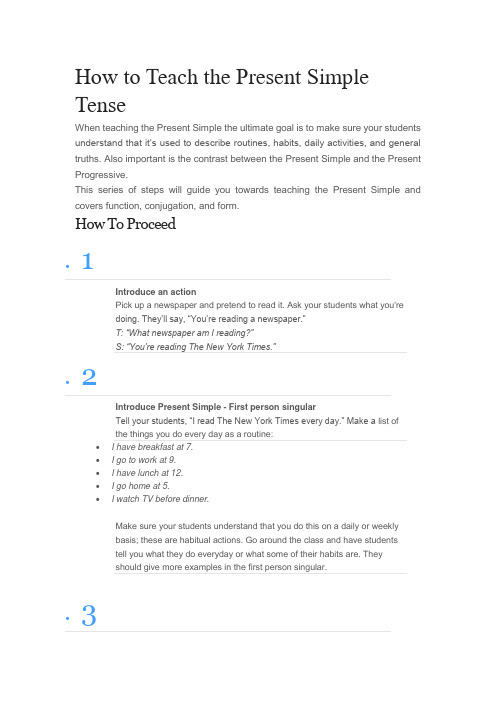
How to Teach the Present Simple TenseWhen teaching the Present Simple the ultimate goal is to make sure your students understand that it’s used to describe routines, habits, daily activities, and general truths. Also important is the contrast between the Present Simple and the Present Progressive.This series of steps will guide you towards teaching the Present Simple and covers function, conjugation, and form.How To ProceedIntroduce an actionPick up a newspaper and pretend to read it. Ask your students what you'redoing. They’ll say, “You’re reading a newspaper.”T: “What newspaper am I reading?”S: “You’re reading The New York Times.”Introduce Present Simple - First person singularTell your students, “I read The New York Times every day.” Make a list ofthe things you do every day as a routine:∙I have breakfast at 7.∙I go to work at 9.∙I have lunch at 12.∙I go home at 5.∙I watch TV before dinner.Make sure your students understand that you do this on a daily or weeklybasis; these are habitual actions. Go around the class and have studentstell you what they do everyday or what some of their habits are. Theyshould give more examples in the first person singular.Introduce Present Simple – Second person singularSay: “I read the New York Times. Sarah, you read USA Today”. Go around the class giving examples like, “I go to work at 9. You go to school.” Face each of your students and state a general truth:T: “John, you live in Queens.”John (to teacher): “You live in Queens, too.”T: “Sally, you have a dog.”Sally (to teacher): “You have a cat”.Split your students up into pairs and have them give each other statements in the second person singular.Introduce Present Simple – Third person singularSay: “I read the New York Times. Sarah reads USA Today”. Make sure students notice that you’ve added the s for the third person singular. Give more examples with other students, and introduce the irregular verbs: John goes to work at 8. Sally has lunch at 1. Students provide more examples from the information previously shared by their classmates.Do the same for the plural personsAsk who lives in Queens and ask them to stand up. Then point to yourself and those standing and say: “We live in Queens.” Ask who lives in the Bronx and ask them to stand up. Address those who are standing and say: “You live in the Bronx”. Point to your group and say, “We live in Queens”. Ask who lives in Manhattan and point to that group and say: “They live in Manhattan.”Introduce Present Simple – NegativeMake a statement in the affirmative, then make one in negative with don’t. T: I live in Queens, I don’t live in the Bronx.Ask students to do the same presenting first an affirmative, then a negative. Practice all persons except the third person singular.Introduce Present Simple – Negative (third person singular)Make a statement about a student, then make one in negative form usingdoesn’t.T: Alex reads the New York Times. He doesn't read USA Today.Ask students to do the same by using the information previously shared bytheir classmates.Introduce Present Simple – QuestionsMake a statement about yourself. Then ask a student a question tointroduce do.T: I walk to school. John, do you walk to school?Walk around the classroom asking students questions and teaching themto answer, “Yes, I do” or “No, I don't”. Do the same for all persons exceptthird person singular.Introduce Present Simple – Questions (third person singular)Contrast students’ habits. Make a statement about one, then ask aboutanother student:T: John walks to school. Does Sarah walk to school?Walk around the classroom asking questions with does, and teach studentsto answer “Yes, he does” “No, he doesn’t”.Expand and practice: Present Simple Excercises.Practice all persons and forms. Ask open-ended questions. Introduce moreverbs.Where do you live?Where does she work?How many languages do you speak?Now’s also a great time consolidate everything that they’ve learned aboutthe Present Simple; this is a great worksheet that will help them focus onform.Obviously, you don't have to follow all of these steps in one single lesson; you can spread them over the course of a week to make sure your students have plenty of time to practice the Present Simple exercises in all its forms. There are literallyhundreds of Present Simple worksheets and lessons plans available at that you can use for in-class activities or give to your students for homework for extended practice. Be sure to check them out!How do we make the Present Simple Tense?There are three important exceptions:1.For positive sentences, we do not normally use the auxiliary.2.For the 3rd person singular (he, she, it), we add s to the main verbor es to the auxiliary.3.For the verb to be, we do not use an auxiliary, even for questionsand negatives.Look at these examples with the main verb like:Look at these examples with the main verb be. Notice that there is no auxiliary:How do we use the Present Simple Tense?We use the present simple tense when:∙the action is general∙the action happens all the time, or habitually, in the past, present and future∙the action is not only happening now∙the statement is always trueLook at these examples:∙I live in New York.∙The Moon goes round the Earth.∙John drives a taxi.∙He does not drive a bus.∙We meet every Thursday.∙We do not work at night.∙Do you play football?Note that with the verb to be, we can also use the present simple tense for situations that are not general. We can use the present simple tense to talk about now. Look at these examples of the verb "to be" in the present simple tense - some of them are general, some of themare now:Permanent or long-lasting situationsWhere do you work?The store opens at 9 o'clock.She lives in New York.Regular habits and daily routinesI usually get up at 7 o'clock.She doesn't often go to the cinema.When do they usually have lunch?FactsThe Earth revolves around the Sun.What does 'strange' mean?Water doesn't boil at 20 degrees.FeelingsI love walking around late at night during the summer.She hates flying!What do you like? I don't want to live in Texas.Opinions and states of mindHe doesn't agree with you.I think he is a wonderful student.What do you consider your best accomplishment?Timetables and schedulesThe plane leaves at 4 p.m.When do courses begin this semester?The train doesn't arrive until 10.35.Common present time expressions include:usually, always, often, sometimes, on Saturdays, at weekends (on weekends US English), rarely, on occasion, never, seldomYou can test your understanding with this present simple quiz.StructurePositiveIn the positive form add an 's' to the base form of the 3rd person singular. If the verb ends in -y preceded by a consonant, change the -y to -ies.I, You, We, They -> eat lunch at noon.He, She, It -> works well in any situation.NegativeConjugate the helping verb 'do' not (don't and doesn't) the base form of the verb to make negatives.I, You, We, They -> don't enjoy opera.He, She, It -> doesn't belong to the club.QuestionsConjugate the helping verb 'do' (do or does) the base form of the verb in question forms.Do -> I, you, we, they -> work in this town?Does -> he, she, it -> live in this city?。
仁爱英语八年级上册教学参考资料教案
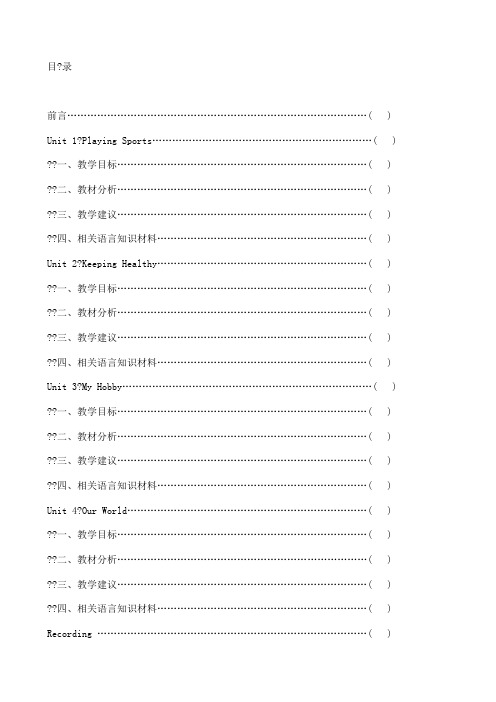
目?录前言………………………………………………………………………………( ) Unit 1?Playing Sports…………………………………………………………( ) ??一、教学目标…………………………………………………………………( ) ??二、教材分析…………………………………………………………………( ) ??三、教学建议…………………………………………………………………( ) ??四、相关语言知识材料………………………………………………………( ) Unit 2?Keeping Healthy………………………………………………………( ) ??一、教学目标…………………………………………………………………( ) ??二、教材分析…………………………………………………………………( ) ??三、教学建议…………………………………………………………………( ) ??四、相关语言知识材料………………………………………………………( ) Unit 3?My Hobby…………………………………………………………………( ) ??一、教学目标…………………………………………………………………( ) ??二、教材分析…………………………………………………………………( ) ??三、教学建议…………………………………………………………………( ) ??四、相关语言知识材料………………………………………………………( ) Unit 4?Our World………………………………………………………………( ) ??一、教学目标…………………………………………………………………( ) ??二、教材分析…………………………………………………………………( ) ??三、教学建议…………………………………………………………………( ) ??四、相关语言知识材料………………………………………………………( ) Recording ………………………………………………………………………( )学生用书参考答案………………………………………………………………( )前?言???? 教材编写组的中外编者们汇聚京华,辛勤笔耕,共同打造了Project English这套有着丰厚文化底蕴的教材。
present simple&present continuous
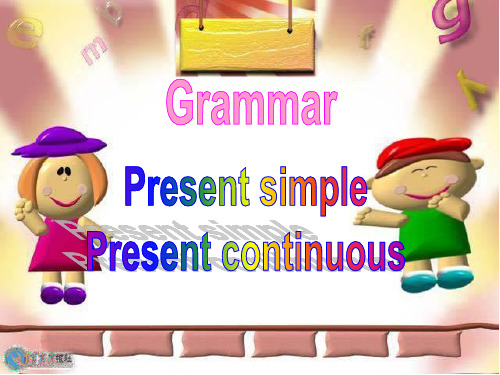
3) 表示“预定”或是“安排好”要发生 的, 不会轻易改变的未来动作、事情。 常用于此类用法的动词有come go, move, stop, leave, arrive, be, finish, continue, start, begin ① The plane arrives at 8 o’clock. 飞机八点到。 ② School begins on September 6th. 九月六日开学。
Ⅱ用所给动词的一般现在时或现在进行时填 空。 am writing 1.I___________(write) a letter to my sister, who works in Beijing. 2.Here the rain season usually comes _____(come) between June and August. 3.Peter________ (drive) to see his grand is driving parents this afternoon. 4.He said the sun ______(rise) in the east rises and ____(set) in the west. sets takes off 5.The plane for Moscow _________(take off) at three o’clock.
objective
To learn Present Simple and Present Continuous
Look at the sentences and find more examples in the texts . 1. For lunch, I have biscuits and a glass of milk. 2. I like the main news at six o’clock. 3. I do some exercise every day. 4. In the evenings, I often watch TV series. 5. I normally wake up about five minutes before my alarm clock goes off.
Present Simple 一般现在时
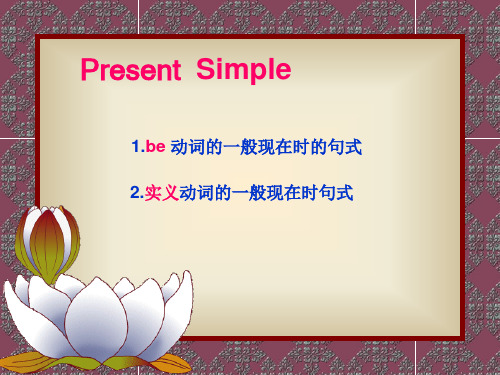
+not+动词原形 动词原形+ ☺主语(He/She/It)+does +not+动词原形+其他 主语(He/She/It) e.g. He doesn’t stay at orts every day.
2.实义动词的一般现在时句式: 实义动词的一般现在时句式: 实义动词的一般现在时句式 一般疑问句: 一般疑问句: Do+主语(I/we/you/they) 动词原形+其他? ☺ Do+主语(I/we/you/they)+动词原形+其他? e.g. Do you stay at home on Saturdays? Do they have sports every day? Does+主语(he/she/it) 动词原形+其他? ☺ Does+主语(he/she/it)+动词原形+其他? e.g. Does he stay at home on Saturdays? Does Lucy have sports every day?
2.实义动词的一般现在时句式: 实义动词的一般现在时句式: 实义动词的一般现在时句式 否定句: 否定句:
主语(I/We/You/They) not+动词原形+ ☺主语(I/We/You/They)+do+ not+动词原形+其他 e.g. I don’t stay at home on Saturdays. They don’t have sports every day.
2.实义动词的一般现在时句式: 实义动词的一般现在时句式: 实义动词的一般现在时句式 特殊疑问句: 特殊疑问句: 疑问词+ do/does+主语+动词原形+其他? ☺ 疑问词+ do/does+主语+动词原形+其他? e.g. What do you want? What does she want? What time do you have lunch? What time does she have lunch? What do you do? What does she do? How do you spell it? How does he spell it?
my daily lift英语作文
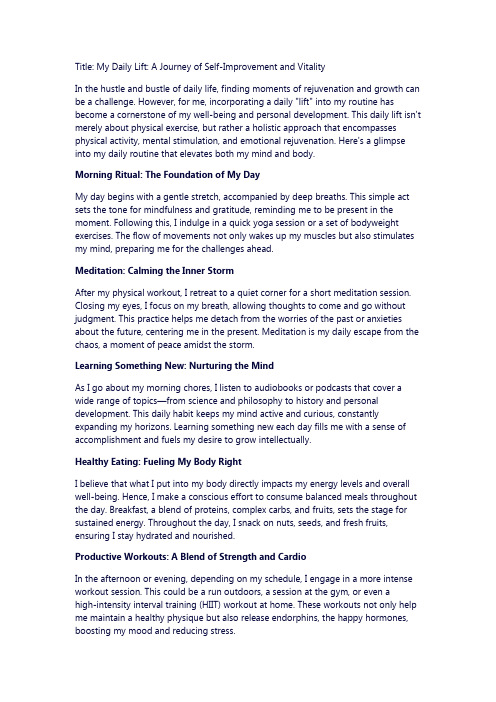
Title: My Daily Lift: A Journey of Self-Improvement and VitalityIn the hustle and bustle of daily life, finding moments of rejuvenation and growth can be a challenge. However, for me, incorporating a daily "lift" into my routine has become a cornerstone of my well-being and personal development. This daily lift isn't merely about physical exercise, but rather a holistic approach that encompasses physical activity, mental stimulation, and emotional rejuvenation. Here's a glimpse into my daily routine that elevates both my mind and body.Morning Ritual: The Foundation of My DayMy day begins with a gentle stretch, accompanied by deep breaths. This simple act sets the tone for mindfulness and gratitude, reminding me to be present in the moment. Following this, I indulge in a quick yoga session or a set of bodyweight exercises. The flow of movements not only wakes up my muscles but also stimulates my mind, preparing me for the challenges ahead.Meditation: Calming the Inner StormAfter my physical workout, I retreat to a quiet corner for a short meditation session. Closing my eyes, I focus on my breath, allowing thoughts to come and go without judgment. This practice helps me detach from the worries of the past or anxieties about the future, centering me in the present. Meditation is my daily escape from the chaos, a moment of peace amidst the storm.Learning Something New: Nurturing the MindAs I go about my morning chores, I listen to audiobooks or podcasts that cover a wide range of topics—from science and philosophy to history and personal development. This daily habit keeps my mind active and curious, constantly expanding my horizons. Learning something new each day fills me with a sense of accomplishment and fuels my desire to grow intellectually.Healthy Eating: Fueling My Body RightI believe that what I put into my body directly impacts my energy levels and overall well-being. Hence, I make a conscious effort to consume balanced meals throughout the day. Breakfast, a blend of proteins, complex carbs, and fruits, sets the stage for sustained energy. Throughout the day, I snack on nuts, seeds, and fresh fruits, ensuring I stay hydrated and nourished.Productive Workouts: A Blend of Strength and CardioIn the afternoon or evening, depending on my schedule, I engage in a more intense workout session. This could be a run outdoors, a session at the gym, or even ahigh-intensity interval training (HIIT) workout at home. These workouts not only help me maintain a healthy physique but also release endorphins, the happy hormones, boosting my mood and reducing stress.Creative Pursuits: Nourishing the SoulTo round off my day, I dedicate some time to a creative outlet. Whether it's writing, painting, or playing a musical instrument, these activities provide a sense of fulfillment and help me express myself freely. Creativity serves as a therapeutic tool, allowing me to unwind and reconnect with my inner self.Reflection and Gratitude: Ending on a High NoteBefore drifting off to sleep, I take a few minutes to reflect on my day. I acknowledge my accomplishments, no matter how small, and express gratitude for the blessings in my life. This practice cultivates a positive mindset and helps me fall asleep with a peaceful heart.My daily lift is a testament to the power of small, consistent habits that, when combined, can lead to significant transformation. It's a journey of self-discovery, growth, and fulfillment, reminding me that each day presents an opportunity to elevate myself physically, mentally, and emotionally.。
daily routine写一篇英文作文
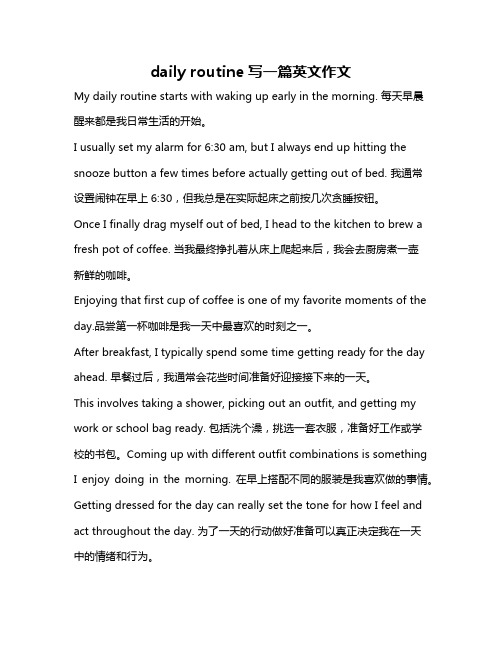
daily routine写一篇英文作文My daily routine starts with waking up early in the morning. 每天早晨醒来都是我日常生活的开始。
I usually set my alarm for 6:30 am, but I always end up hitting the snooze button a few times before actually getting out of bed. 我通常设置闹钟在早上6:30,但我总是在实际起床之前按几次贪睡按钮。
Once I finally drag myself out of bed, I head to the kitchen to brew a fresh pot of coffee. 当我最终挣扎着从床上爬起来后,我会去厨房煮一壶新鲜的咖啡。
Enjoying that first cup of coffee is one of my favorite moments of the day.品尝第一杯咖啡是我一天中最喜欢的时刻之一。
After breakfast, I typically spend some time getting ready for the day ahead. 早餐过后,我通常会花些时间准备好迎接接下来的一天。
This involves taking a shower, picking out an outfit, and getting my work or school bag ready. 包括洗个澡,挑选一套衣服,准备好工作或学校的书包。
Coming up with different outfit combinations is something I enjoy doing in the morning. 在早上搭配不同的服装是我喜欢做的事情。
Getting dressed for the day can really set the tone for how I feel and act throughout the day. 为了一天的行动做好准备可以真正决定我在一天中的情绪和行为。
simple present tense用法
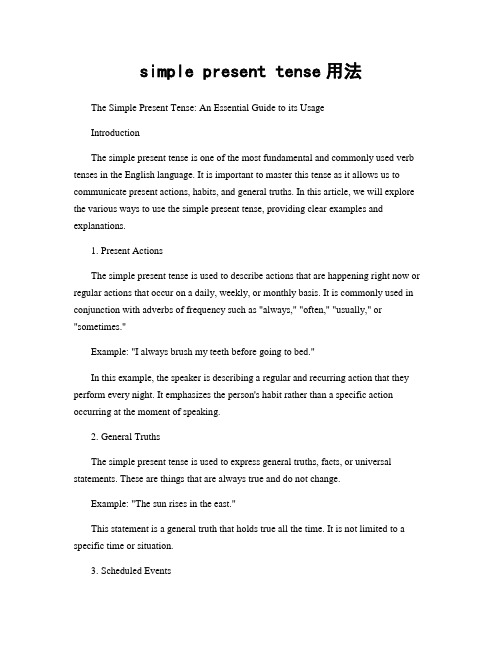
simple present tense用法The Simple Present Tense: An Essential Guide to its UsageIntroductionThe simple present tense is one of the most fundamental and commonly used verb tenses in the English language. It is important to master this tense as it allows us to communicate present actions, habits, and general truths. In this article, we will explore the various ways to use the simple present tense, providing clear examples and explanations.1. Present ActionsThe simple present tense is used to describe actions that are happening right now or regular actions that occur on a daily, weekly, or monthly basis. It is commonly used in conjunction with adverbs of frequency such as "always," "often," "usually," or "sometimes."Example: "I always brush my teeth before going to bed."In this example, the speaker is describing a regular and recurring action that they perform every night. It emphasizes the person's habit rather than a specific action occurring at the moment of speaking.2. General TruthsThe simple present tense is used to express general truths, facts, or universal statements. These are things that are always true and do not change.Example: "The sun rises in the east."This statement is a general truth that holds true all the time. It is not limited to a specific time or situation.3. Scheduled EventsThe simple present tense is also used to talk about future events that are fixed or scheduled, such as timetables or routines.Example: "The train leaves at 8:00 am tomorrow."In this case, the speaker is referring to a future event that is scheduled to happen at a specific time. The present tense is used to describe the fixed timetable.4. Narrating Events in LiteratureThe simple present tense can be used in storytelling or literature to give a sense of immediacy and to create a vivid present experience for the reader.Example: "She walks into the room, her eyes scanning the crowd for familiar faces."In this example, the author is using the simple present tense to describe the character's actions as if the reader is experiencing them in real-time.5. Commentaries and SportsThe simple present tense is commonly used in commentaries or live sports reporting. It provides a dynamic and up-to-date account of ongoing events.Example: "The striker shoots and scores! The crowd erupts in cheer!"In sports reporting, the use of the simple present tense gives a sense of excitement and allows the audience to feel as if they are witnessing the action in real-time.ConclusionThe simple present tense is a versatile verb tense that is essential for effective communication in English. It can be used to describe present actions, express general truths, talk about scheduled events, create a sense of immediacy in storytelling, and provide live commentary on events. Mastery of the simple present tense is vital for building a strong foundation in English grammar and communication. So, let's practice using the simple present tense to ensure clear and accurate expression in our everyday interactions.。
PresentSimpleandPresentContinuous1
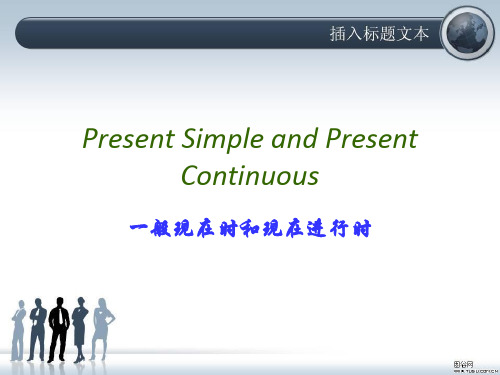
一般现在时和现在进行时
Present simple(一般现在时)
1.Couch potato often has biscuits and a glass of milk for lunch. 2.Sometimes he takes his dog Tina out for a walk. 3.I get up very early every morning. 一般现在时表示经常发生的动作、习惯性的 动作。常与always, usually, often, sometimes, on Tuesdays, every day, twice a year等连用。
但如果词义转变,能表示一个正在进行的动作, 就能用于进行时态。 Do you see anyone over there? (表感觉) Are you seeing someone off?
(表正在进行的动作)
He looks very young. (表感觉和状态) He is looking for his pen. (表正在He / she / it
do does
Present simple(一般现在时)
Choose the correct form. gets 1.He get/gets up late. 2.My father goes go/goes to work early. 3.We like like/likes fishing. 4.My cat often catch/catches mouse catches during the night.
Present simple(一般现在时)
1. The sun rises in the east and sets in the west. 2. Famous people suffers from a lot of stress. 3. Light travels faster than sound. 表示客观事实或客观真理。
simple present一般现在时
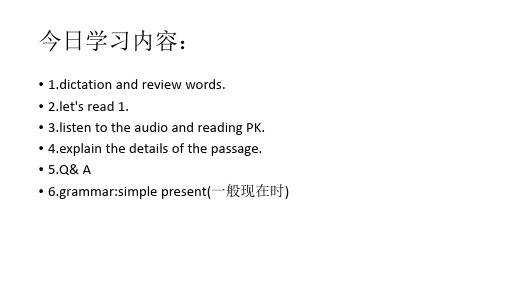
今日学习内容:
• 1.dictation and review words. • 2.let's read 1. • 3.listen to the audio and reading PK. • 4.explain the details of the passage. • 5.Q& A • 6.grammar:simple present(一般现在时)
ch,sh,o,x,ss,es +es consonant +y
去掉y,+ies
do---does catch---catches mix---mixes cry----cries try----tries study----studies
4.kely goto school.
5.Jim studyvery hard. 6.The baby cries everyday.
3rd person
He eats pizza. She drinks cola. They open presents .
V+S
walk----walks make---makes look---looks cook---cooks True or fause 1.A bird fly in the sky. 2.emily catch the ball. 3.sam brush his teeth.
1st ,2nd person
I eat pizza You drink cola. We open presents .
1.She swim well. 2.I draws a picture. 3.You eats an apple. 4.We watches a movie. 5.Eric on the coach. 7.He walk to school .
(过程)Present Practice Produce (PPP)
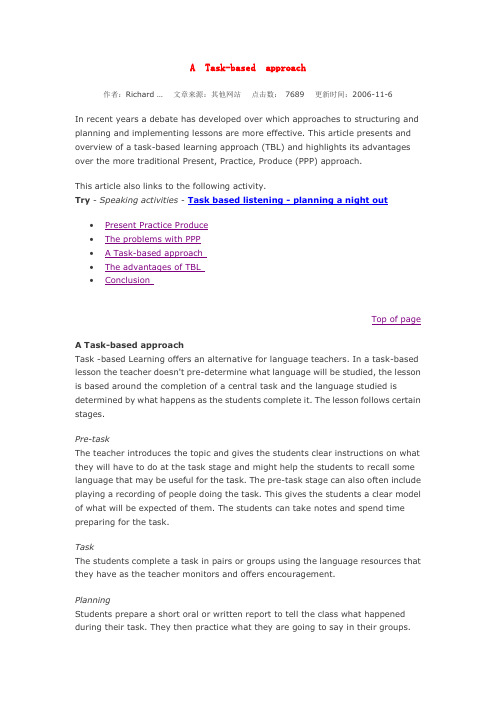
A Task-based approach作者:Richard …文章来源:其他网站点击数:7689 更新时间:2006-11-6In recent years a debate has developed over which approaches to structuring and planning and implementing lessons are more effective. This article presents and overview of a task-based learning approach (TBL) and highlights its advantages over the more traditional Present, Practice, Produce (PPP) approach.This article also links to the following activity.Try - Speaking activities - Task based listening - planning a night out•Present Practice Produce•The problems with PPP• A Task-based approach•The advantages of TBL•ConclusionTop of pageA Task-based approachTask -based Learning offers an alternative for language teachers. In a task-based lesson the teacher doesn't pre-determine what language will be studied, the lesson is based around the completion of a central task and the language studied is determined by what happens as the students complete it. The lesson follows certain stages.Pre-taskThe teacher introduces the topic and gives the students clear instructions on what they will have to do at the task stage and might help the students to recall some language that may be useful for the task. The pre-task stage can also often include playing a recording of people doing the task. This gives the students a clear model of what will be expected of them. The students can take notes and spend time preparing for the task.TaskThe students complete a task in pairs or groups using the language resources that they have as the teacher monitors and offers encouragement.PlanningStudents prepare a short oral or written report to tell the class what happened during their task. They then practice what they are going to say in their groups.Meanwhile the teacher is available for the students to ask for advice to clear up any language questions they may have.ReportStudents then report back to the class orally or read the written report. The teacher chooses the order of when students will present their reports and may give the students some quick feedback on the content. At this stage the teacher may also play a recording of others doing the same task for the students to compare.AnalysisThe teacher then highlights relevant parts from the text of the recording for the students to analyse. They may ask students to notice interesting features within this text. The teacher can also highlight the language that the students used during the report phase for analysis.PracticeFinally, the teacher selects language areas to practise based upon the needs of the students and what emerged from the task and report phases. The students then do practice activities to increase their confidence and make a note of useful language.Top of pageThe advantages of TBLTask-based learning has some clear advantages•Unlike a PPP approach, the students are free of language control. In all three stages they must use all their language resources rather than just practising one pre-selected item.• A natural context is developed from the students' experiences with the language that is personalised and relevant to them. With PPP it is necessary to create contexts in which to present the language and sometimes they can be very unnatural.•The students will have a much more varied exposure to language with TBL.They will be exposed to a whole range of lexical phrases, collocations andpatterns as well as language forms.•The language explored arises from the students' needs. This need dictates what will be covered in the lesson rather than a decision made by the teacher or the coursebook.•It is a strong communicative approach where students spend a lot of time communicating. PPP lessons seem very teacher-centred by comparison. Just watch how much time the students spend communicating during atask-based lesson.•It is enjoyable and motivating.ConclusionPPP offers a very simplified approach to language learning. It is based upon the idea that you can present language in neat little blocks, adding from one lesson to the next. However, research shows us that we cannot predict or guarantee what the students will learn and that ultimately a wide exposure to language is the best way of ensuring that students will acquire it effectively. Restricting their experience to single pieces of target language is unnatural.。
小学英语 The Present Simple Grammar
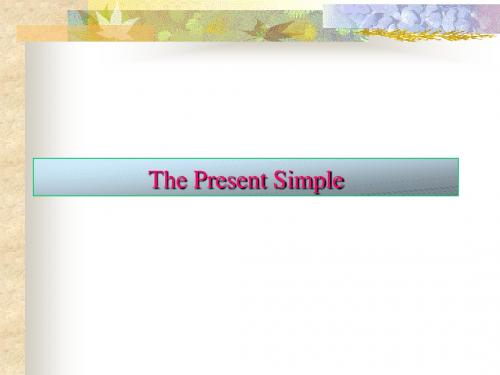
Time expressions
There are time expressions that we use only with the Present Simple and they are:
1.Every day, every Friday, every week, every month, every summer, every month, every year, always, usually, etc. 2.All the time .
.
1.
I work in a bank.
2._____________________________________? My brother is an engineer.
3.___________________________________? He lives in an apartment building.
think we
? Do we think
think you
? Do you think
Negative . I do not think . You don't think . He, she, it doesn't think . We don't think . You don't think
x
he fixes
sh
it push es
ss
he pass es
ch
she catch es
o
He go es
C: Verbs ending in y ;the third person changes the y to ies
fly flies
cry
(暑假一日一练)2020七年级英语下册 Unit 2 What time do you go to school教案 (新版)人教新目标版
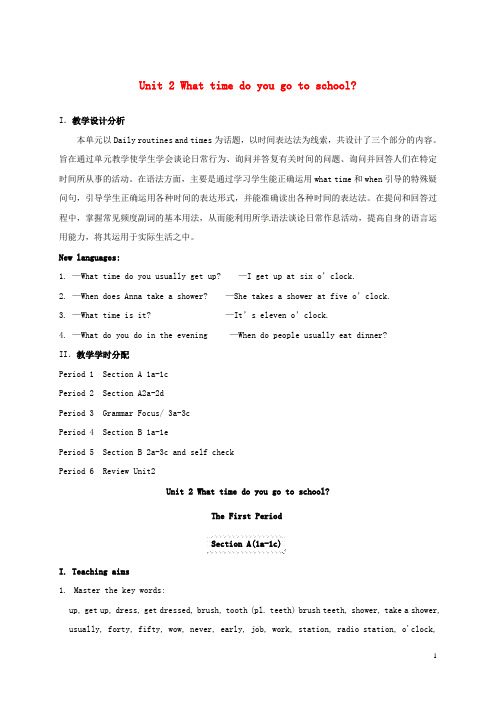
Unit 2 What time do you go to school?I.教学设计分析本单元以Daily routines and times为话题,以时间表达法为线索,共设计了三个部分的内容。
旨在通过单元教学使学生学会谈论日常行为、询问并答复有关时间的问题、询问并回答人们在特定时间所从事的活动。
在语法方面,主要是通过学习学生能正确运用what time和when引导的特殊疑问句,引导学生正确运用各种时间的表达形式,并能准确读出各种时间的表达法。
在提问和回答过程中,掌握常见频度副词的基本用法,从而能利用所学语法谈论日常作息活动,提高自身的语言运用能力,将其运用于实际生活之中。
New languages:1. —What time do you usually get up? —I get up at six o’clock.2. —When does Anna take a shower? —She takes a shower at five o’clock.3. —What time is it? —It’s eleven o’clock.4. —What do you do in the evening —When do people usually eat dinner?II.教学学时分配Period 1 Section A 1a-1cPeriod 2 Section A2a-2dPeriod 3 Grammar Focus/ 3a-3cPeriod 4 Section B 1a-1ePeriod 5 Section B 2a-3c and self checkPeriod 6 Review Unit2Unit 2 What time do you go to school?The First PeriodSection A(1a-1c)I. Teaching aims1.Master the key words:up, get up, dress, get dressed, brush, tooth (pl. teeth) brush teeth, shower, take a shower, usually, forty, fifty, wow, never, early, job, work, station, radio station, o'clock,funny, exercise2. Get students to master the target language.①—What time do you usually get up? —I usually get up at six thirty.②—When do you go to work? —I usually go to work at eleven o'clock.③—He has an inte resting job. —He works at a radio station.3. Be able to use when and what time to ask about times and master the expressions aboutadverbs of frequency.4. Learn to make plans about daily routines and learn to arrange their times properly. II. Key points1. Master the key words and expressions.2. Master the language points of the simple expressions about time.3. Be able to talk about their daily routines by using the target languageDifficult point:1. The usage of the what time and when question in simple present tense.2. Talk about daily routines by using the adverbs of frequency and time expressions correctly..III. Teaching aidsMultimedia/A tape recorder/A blackboardIV. Teaching proceduresStep 1 Lead-in1. Greet the Ss as usual.2. Present some sentences about time and lead to the topic of Unit 2.Step 2 Presentation1. show Ss a clock that can run. Then change the clock and ask Ss about the time using thequestion “What time is it?”。
